You've got Shadowdark all wrong!
Can Kelsey Dionne set you straight?
Greetings, Kelsey! How would you introduce yourself to the general RPG crowd who might be reading this interview?
Hi, Dave! I’m Kelsey Dionne, creator of an RPG publishing company called The Arcane Library. I specialize in 5E D&D adventures with unconventional formatting, and I’m also working on an old-school overhaul (gutting?) of the 5E rules called Shadowdark RPG.
I’ve read I think almost all of your 5e adventures thus far. They all have the distinct quality of being succinct and distilled to exactly what the DM needs to convey specific imagery and dilemmas within a theme. How did you apply these principles in your latest, biggest project, Shadowdark?
“Succinct” and “distilled” are great words for what I was going for in my 5E adventures, so I’m glad that came through!
Those adventures were definitely a proving ground that eventually led to me creating Shadowdark RPG. When I first started writing 5E adventures, I was coming at the process very dissatisfied with the standard presentation most D&D adventures used (the “Dungeon Magazine” style fueled by the pay-per-word publishing model where more = better). I always had a lot of trouble slogging through those adventures and turning them into something usable at the table.
So I ended up getting elbows-deep into taking apart and rebuilding the typical adventure presentation method. I really zeroed in on making the adventure look and handle the way I wanted it to, with the goal being “less is more.” I even rewrote my first published adventure (The Secrets of Skyhorn Lighthouse) from scratch three times over six months to experiment with and refine the presentation style I would use.
The end result was surprising; I found that I could make things easier on the DM, and I could boil the adventure down to a more usable document that fit what I needed to run a good game.
I think that desire to tinker with the conventions made me realize that if I wanted something to work in a certain way, I had the power to make it happen. I just had to put in the elbow grease and ignore the little internal voice telling me I was tampering with sacred cows. Once I saw I could customize in such a way, it became a slippery slope that eventually led to me designing my own game from the ground up.
It all does come back to adventure-writing, in the end. The main reason I started working on Shadowdark was because I was itching to have a system that would let me write (and run) the kinds of exploration-focused, “modern OSR” adventures I wanted to see. 5E wasn’t really equipped to do that without an enormous amount of house-ruling, so I started to think, “If I can redesign adventure presentation, maybe I can really stick my hands into the pie and change the overall recipe…”
Ultimately, my experimentation in making 5E “how I wanted it” gave me way more agency than I ever thought I could have. I realized I could make everything exactly how I wanted it, and thus, Shadowdark RPG came to be!
So there was this big, harrowing, godawful chapter in tabletop RPGs that just unfolded a couple months ago where Wizards of the Coast tried to revoke their Open Gaming License and start charging some creators to use their D&D 5e rules (Systems Reference Document 5.1). It caused a huge backlash in the community and WotC eventually capitulated and released their SRD 5.1 under a very generous CC-BY (Creative Commons with attribution) license. Where were you and Shadowdark during this huge debacle and where did you land in the aftermath?
It was weird to see history unfolding right before our eyes, wasn’t it? I was one week into having the final, approved proof copy of Shadowdark RPG sitting on my desk when this happened. This, of course, is a lesson in never naming a file “Final Version.”
In all seriousness, it was a bad week. Shadowdark RPG was built with the OGL 1.0a under my false beliefs about the license’s permanence, and so I was suddenly sitting with a finished book that had to be thoroughly re-written.
The first few days were a mixture of panic and misery as the whole community tried to sort out what was permissible without the OGL. Could we use the six core stats? Are halflings a forbidden word? Can I keep fireball’s mechanics if I rename the spell?
Lots of misinformation flew around, and the view of what would come was very dim based on the OGL 1.1 draft, and the second draft that was not much better than the first.
In the end, my community showed up for me in a way that I couldn’t have seen coming in such a crisis. Folks picked up extra copies of my work and gave me the financial resources to fight, so I did! I re-drafted and re-laid out four three chapters (and many tiny bits of other chapters) of Shadowdark RPG with the help of a great legal team to strip out any OGL or intellectual property concerns. I somehow did that all in one week. I’m not sure I slept.
Shadowdark’s gameplay didn’t change, but a lot of terminology got altered or streamlined. Every monster, spell, and magic item got renamed, and almost all of them mechanically altered in some way. The rewrite added 10 pages and 24 art pieces to the book, and the amazing illustrators I worked with on this project leaped to help and turn around the new pieces in record time.
Not being able to use the OGL forced me to let go of some of the “D&D vernacular” and tropes I had been using, and it allowed some new creativity. Originally, I used those elements to inject some familiarity and nostalgia into the game. But the rewrite was a refreshing (and painful) gutting that strengthened some ideas and revealed areas that could be further streamlined.
A few weeks later, WotC changed course with the CC-BY release of the SRD. Major whiplash! It took a few days for me to mull over how to proceed. I trusted the CC-BY material since it was now out of WotC’s stewardship, but I wasn’t sure I wanted to fully go back to all the prior material. So in the end, I compromised. Several changes stuck (including renaming “stirge” to “stingbat,” an act of humorous defiance). I returned to some of the former layout and material, but now with a tightening of the concepts. I had always wanted Shadowdark RPG to feel like D&D, but I realized it didn’t need to cleave quite as close in order to maintain that vibe.
Somehow, the project stayed on track for its original launch date. Three zines, the book, and all the supporting material made it through the fiery gauntlet of legal apocalypse! It’s almost like it never happened… almost. The stingbats will never forget.
You’ve let me see the latest revision of Shadowdark and at a glance, I’m seeing eye-popping black-and-white artwork reminiscent of certain artists of the old school. And the game is about dungeon delving, treasure hunting and monster killing. But we’re now what might be about 15 years into the OSR movement, and there have been a lot of games like this published in that time span. What makes Shadowdark unique for players/GM? Or maybe that’s the wrong question. Does Shadowdark have a purpose other than being unique?
You are very perceptive, Dave! A lot of people want to know right away how Shadowdark is different, but being different wasn’t the point unto itself. I wanted to make a game about dungeon crawling with low-powered adventurers in a fantasy setting, so I wasn’t out to cut any new ground on that front. Instead, Shadowdark became about how to rework the classic dungeon crawling experience with modern game design. That idea became the singular obsession. I wondered, “what would fantasy dungeon crawling have looked like if it had been able to benefit from the last 50 years of innovation?”
So Shadowdark began kind of pouring out of me. It wasn’t a retro-clone, and it wasn’t just a stripped-down 5E, either… it turned out to be a dungeon crawler built around real-time mechanics and tightly controlled inventory. That’s the core of it. I remember having a revelation about torches needing to last an hour of real-world time while I was eating corn on the cob at dinner, and thinking, “this is the missing link to every problem I’ve been trying to solve!” There’s very little that will take a Wisconsinite away from buttered-and-salted corn on the cob, but I went running to my notebook.
The fun part about working on Shadowdark was it was kind of like getting into a time machine, going back to Gary Gygax, and saying things like, “Believe me, THAC0 didn’t pan out. Ascending armor all the way. And thousands of gold pieces just to fuel an XP system with all those unnecessary zeroes in it? We can cut that down, make it so much simpler…” A bit audacious, but I like to imagine he would have at least heard me out.
So really, the central purpose of Shadowdark turned out to be a more graceful rebuild of classic fantasy dungeon crawling. The emphasis wasn’t on different, but on “better, faster, stronger.” I hope folks see the love and nostalgia in Shadowdark RPG, but also the obsessively crafted changes to the gameplay experience!
Nice. I have to confess that as an RPG reviewer I’m constantly, almost obtusely, looking for novelty, so certain creative intentions can sail right over my head. Consider me fully onboard with Shadowdark now. So, your previous publications have included a number of 5e adventures, and one of them, The Secrets of Skyhorn Lighthouse, was run at Roll20 Con on Twitch with the likes of Aabria Iyengar of Critical Role and Dimension 20 fame, as well as Brennan Lee Mulligan, Mica Burton, Becca Scott and Travis McElroy. How did your self-published 5e adventure from 2017 eventually wind its way onto that table?
I have to say that my jaw hit the floor when I learned their production team wanted to use my adventure for this!
I think Skyhorn Lighthouse is the adventure that really paved my destiny. It’s the first one I ever released, and back in 2017, I was convinced nobody would like how much I had fiddled with the conventional way an adventure was supposed to be written. I released it for free, imagining the no-cost download would assuage the disappointment of it not being what people expected.
It caught me by surprise that folks not only welcome the approach I took, they actually really enjoyed the adventure, too. It rocketed up to the “highest rated free adventure” spot and stayed there for months, which gave it a lot of eyes and consideration. It continues to be the highest rated adventure of all time on DMs Guild, although I think the algorithm gives the top spot on the list to titles with perfect 5.0 ratings instead of overall volume of ratings these days. But I ain’t complaining!
I think the adventure ended up becoming a sort of shared experience among a lot of 5E players in a similar (though certainly smaller) way that adventure paths like Curse of Strahd or Mines of Phandelver are a shared experience. Enough people had seen and heard of Skyhorn Lighthouse that there was a legitimate chance they could talk to each other about it, which was wild.
I think Skyhorn Lighthouse got chosen for the Roll20 Con team due to that fact, and also because it was easily convertible to Roll20 and playable in one session. A perfect storm, really. I was so nervous to see how it all went for the live play group, and to know DMs and players of such acclaim were scoping out my writing. I’m glad it worked for what they were going for!
I knew it was a killer adventure, but I didn’t realize the scope of its success. Amazing! You pretty much run a business at this point, partly as a result of that early success, right? But you haven’t ever done a Kickstarter or crowdfunded publication. Where does the notion of crowdfunding sit with you currently and why?
This is indeed my full-time job these days! It’s still pretty surreal that I get to say that. And you’re right, I’ve never done my own Kickstarter or crowdfunding project!
That’s going to change with Shadowdark RPG, but it wasn’t without a lot of consideration. I had originally shied away from crowdfunding for a few reasons. I already have a strong direct sales platform with my audience, so a couple years back when I was looking into Kickstarter, I didn’t see a big need to bring in an outside platform that would just put a middle-man between me and my supporters.
But over time, Kickstarter has proven itself to be a massive platform TTRPG players use to find new creators, and vice versa. It’s really as powerful of a marketplace as titans like DriveThruRPG. So I realized (with the help of brilliant folks like Sean McCoy of Mothership fame)(Dave’s interview with Sean) that my stubbornness in avoiding Kickstarter was more a fear of going outside my comfort zone rather than doing what was good for The Arcane Library. My decisions needed reevaluation!
My caution wasn’t totally unfair, of course. We’ve all seen some promising Kickstarters fail spectacularly and bring down careers along with them. I worried that Kickstarter would too easily set me up for overpromising, not hitting goals, or disappointing my audience in some way that had never been a problem before.
For example, the temptation to take the money first and do the work second is strong with crowdfunding. But that’s just not the way I do things; I don’t publish something until it’s fully produced and ready to go, and I wouldn’t be comfortable going any other way. It definitely puts the risk more on me as the sole creator and financier of these projects, but I think it also keeps me accountable only to myself and my own capabilities. It lets me focus on the work rather than the money. And there are no rules saying you can’t come to Kickstarter with the project already done!
So that’s what I’m doing for Shadowdark RPG. It’s going to Kickstarter in March 2023 (right over Gary Con – come find me there, eh?). I did everything I could to avoid the crowdfunding pitfalls. The book is fully written and laid out, and all the art is the bag. Playtesting has been going on for almost three years at this point. All the proofs are approved, and I’ve tested the shipping method I’m planning to use. There will be simple and reasonable stretch goals, and plenty of possible add-ons (already done or otherwise extremely simple to make) in support of the game. I think that’s about as buttoned-up as I can make it!
And it took me two full years to get Shadowdark RPG to this point. Jumping the crowdfunding gun wouldn't have allowed me the time and experimentation I needed, so I’m glad I took the slow and steady approach before launching. I hope I’ll be getting the best of both worlds – a game that’s already complete, and the vast audience Kickstarter can bring to it.
Then, I can turn my attention right away to supporting new Shadowdark players and making more material for them, rather than beginning what turned out to be a multi-year project!
You mentioned that you’ve already established a direct sales business. Most creators are familiar with publishing through DrivethruRPG.com or Itch.io, and to a lesser extent through a publisher like Exalted Funeral or Free League. But what does a direct sales operation look like?
I think the only major difference between what I do vs. publishing on DTRPG or itch.io is that I have my own website I use to sell and distribute my work. It seems like a small difference, but it gets deep if you look under the hood. What I’m doing with direct sales is relying on a healthy existing audience (primarily managed through my email newsletter), and then sending traffic directly to my website when I launch new material rather than a third party marketplace.
There are challenges and benefits to this method. Challenge-wise, I have to work all the time to be “discovered.” People go to DTRPG when they’re looking to buy RPG material, but they don’t just head on over to thearcanelibrary.com unless they already know about me. However, I have a lot more control over how I bring people to my website – my platform (Shopify) has excellent metrics tracking and Google discoverability, plus the ability to have things like a blog on my site that pulls in further organic traffic. So I get a trickle of traffic all the time that hopefully converts into returning visitors. It snowballs.
The upshots, to me, are massive. I don’t have to pay a 30-50% royalty on a sale, which means I get to keep a huge amount of the profit to put back into the business. My profit margin on a digital product is somewhere north of 95%, which is eyeball-popping. If someone gives me $50, I generally keep about $48 of it. On DTRPG, I would have only kept about $30 of it (even worse on DMs Guild). That really adds up over hundreds and thousands of product sales.
Furthermore, because I have a full-fledged website, I’m in control of what’s on it and how it all works together to pull in organic traffic. If I run ads, I can see meaningful data about whether those ads are working. I get to keep in contact with my customer base much more directly than a site like DTRPG permits. And when folks are on my website, I don’t have to compete with other creators for their attention, or quickly get buried a day after launching a new product – it’s a closed ecosystem where I get to manage what’s front-and-center, and for how long.
Setting up a direct sales website and growing it over time isn’t fast or easy, and you will always have to fight for eyeballs on your work. So it’s not always a best-fit for all creators. But the reward is a strong, dedicated group of supporters who grow over time and who will return to your platform over and over again – maybe even with their friends in tow!
As a side note, digital products were my primary way of growing when I first started out with direct sales. They’re no-fuss, instant delivery, and the TTRPG space now broadly embraces PDFs. Especially in the D&D sphere, many buyers now want to use material on VTTs more often than not, so digital elements are an expectation.
I do have physical products nowadays, and they add some complexity that a print-on-demand service would otherwise take care of. But I get to be in full control of the quality of the materials, which is very important to me. Plus, I actually enjoy the process of packaging and fulfilling orders (made much easier by a little “product fulfillment workspace” in my house). I go to the post office a couple times a week with a manageable stack of packages. If I suddenly had a huge spike in physical product sales beyond what I could do myself, I’d look at outsourcing that to a fulfillment partner like Quartermaster Logistics.
Suffice to say, with direct sales, you have to be aware of and keep an eye on the whole business from end-to-end, creation to fulfillment. There isn’t much that someone else handles, but there are many tools available to make it easy for a sole owner/operator to manage.
What are some big lessons you’ve learned along the journey of creating your own business in the RPG space?
The lessons always keep coming, but I think that’s the first lesson, actually – always seeking to expand and grow in new directions. I’ve found that the best state to be in is a mix of learning and implementing. Otherwise, it’s easy to grow stagnant and actually get bored with what you’re doing! I’m not saying to start completely changing your publishing goals, but rather to add new skills and experiences to your arsenal. Learn a new software platform. Practice hand-drawing maps. Investigate a new sales channel. Try your hand at a different style of material outside your comfort zone.
I also really agreed with what the excellent Sean McCoy said in his interview with you about focusing on your own work and goals. It’s incredibly easy to get tempted into cool side projects, take on hired work for big names you respect, or divert your attention into a collaboration. And it’s not always something to avoid, either, but it’s just so easy to look up from your computer and realize you’re working on six projects that have nothing to do with your original publishing goals. Too much of that can derail your momentum and focus. I’ve had to learn this lesson the hard way more than once in my career.
The fact is, you should be building your dreams first, and everyone else’s dreams a distant second. Be resolute about protecting your time. The more you grow, the more requests will come your way, and you have to start steeling yourself to give a regretful “no” to everything but the most exciting opportunities. I think I’ve only regretted turning down one collaboration – and even then, not so much!
A third lesson is that “scroll-and-like” social media is very overrated (I exclude YouTube from this!). It has almost zero value from a time and financial standpoint. Start an email newsletter for your followers, and ignore the allure of Twitter, Instagram, and Facebook. Advertising on these platforms can be useful (although less so every day; Facebook has posted big losses coupled with increased prices through their ad platforms in 2022, and Google’s prices are skyrocketing, too), but ads are a very different strategy than scroll-and-like content posting. By and large, developing your socials is a massive waste of time.
To illustrate, consider this: If you have 10,000 Instagram followers, only about 2% of them will see a post you make. From there, about 1% will take action on your post, such as buying a $10 product you just released. You make two sales for $20 earned. These numbers would be similar on Twitter.
With a well-maintained email newsletter, 99% of your 10,000 subscribers would see your product launch, and about 1% of them would take action (but often more, since newsletter subscribers tend to be more invested in your work). That’s 99 sales, or $990 earned. If even 2% took action, that’s $1,980 earned. A vast difference. So don’t waste your valuable time and energy on socials; grow and maintain your newsletter.
A final lesson I’ve been embracing is that I should follow my interests and expect them to develop and change over time. There’s no reason to pigeon-hole myself into a particular category of creator if the shoe won’t fit in a year or two. New games are coming out all the time, D&D editions are changing, and next month, I could discover a latent love for 1920s paperback sci-fi novels I never knew I had. So I’ve been reminding myself to move forward with the natural development of this hobby and my interests, and doing this has been a wellspring of passion and motivation for me. That mentality is how I jump back and forth between the “5E adventure writer” and “old school game designer” mantles I wear without feeling like I’m somehow cheating. Don’t typecast yourself!
Pure gold. And thanks for the reminder to get off of Twitter. I only recently discovered something about your past, as revealed in your interview with Ben Milton of Questing Beast, but you have some pretty interesting connections to some original D&D creators. Can you share those here?
Absolutely! I grew up in southern Wisconsin, which was an important location in the origin story of Dungeons & Dragons (although I didn’t know that at the time). In my first year of middle school, I made friends with a bunch of like-minded nerds and spent every Saturday with them at the local gaming store in our hometown. We were all D&D fans, but we were very unschooled in how it all worked.
One Saturday, a friend of the game store owners came by the shop and ran a D&D session for us. This game was set in the City State of the Invincible Overlord, and it was leagues above what we had been able to pull off on our own. We were mind-boggled at how awesome it was! The Dungeon Master was none other than Mr. James Mishler, a gaming industry veteran who was playing in Gary Gygax’s weekly games at the time. He also regularly worked with folks like Bob Bledsaw of Judges Guild (the two had recently started a game publishing company together). So James was down in Lake Geneva on Thursday nights rolling dice with Gary’s crew, and then coming back home by the weekend where he was running games for us in the very first city setting ever made for D&D.
James was an incredible mentor to us pack of wild nerdlings, and I think he saw it as his responsibility to pass along the lessons of D&D gaming to us the way his former mentors did for him. He really instilled a reverence for the game in all of us, and made us feel like welcome members of the gaming community at large. He even gave us the chance to contribute some monsters and ideas to work he published that was licensed by Judges Guild – a newsletter called the Byrny Royal Herald (“Chartered in the City State of the Invincible Overlord,” as the cover read!). To this day, it’s one of the rarest pieces of officially licensed Judges Guild material in existence. I still have my copy, too!
James was responsible for me getting to meet Gary in person at Gen Con while it was still taking place in Milwaukee. My birthday usually falls over the convention, so James pulled Gary aside and asked if he wouldn’t mind surprising me with a visit and a pep talk about how I should become a Dungeon Master (James knew I had aspirations to sit behind the DM screen). And Gary did just that – he took time out of his busy con schedule to meet personally with me and a few friends, chat for a bit, and sign my brand new DMs Guide. He told me I should become a Dungeon Master, and I’ll never forget his humorous advice to me: “Slap your players around like red-headed dwarves!” Once The Dungeon Master bids you to take up the mantle, you had better do it, right? And so I did!
I was fortunate to grow up where I did and have mentors with such an incredible connection to and love for D&D. To this day, James runs games for our old middle school group as often as we can meet online. He’s still publishing material, too, and it’s some of the coolest OSR stuff out there. Bryce Lynch at tenfootpole.org just recommended one of his recent adventures called The Demon Tower of Veldig Fel! Well worth scoping out.
So, my presence in this industry goes all the way back to James putting the genuine D&D bug in our group of friends and showing us the game’s incredible potential. He’s too humble to sing his own praises, so I’m always delighted at the chance to do so myself!
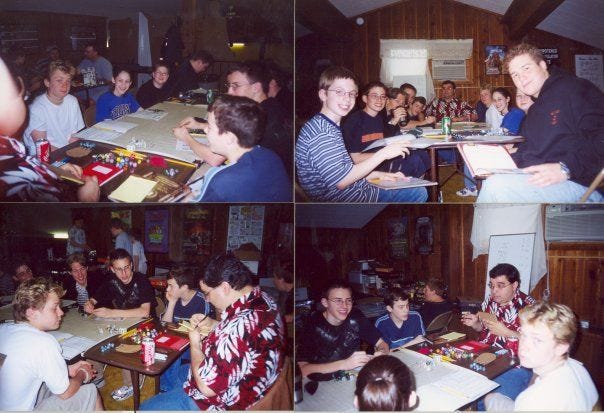
That’s just such a cool story. That bonafide Midwest pedigree is hard to beat! I really just have one more personal question to ask you, but before I do, are there any topics that have really been occupying your mind these days? You mentioned needing to always try something new. What have you recently forced yourself to learn that’s outside your comfort zone?
This is so silly, but lately I’ve been trying to learn the art of letting other experts handle things for me. I’m a one-lady show, so I often feel like I have to do it all: writing, design, marketing, graphic layout, website building, logistics. And while it’s important to understand how those things work, it’s been eye-opening to allow some of those tasks to pass off to other trusted folks (especially in light of the Shadowdark RPG Kickstarter).
It’s hard to let someone else hold your baby, so to speak. But The Arcane Library isn’t a fragile newborn anymore, and so bringing experts on to help with the various aspects of running the business has been an overwhelmingly positive experience. I’m proud and amazed to say that when people look at the Kickstarter page (and the book itself), they’re seeing the hands of many incredible creators at work. The artists, the video designers, marketing teams, musicians, and the collective insight of many other industry professionals. I wish I’d been willing to “let go” and seek their help earlier into my career!
Yeah, division of labor can be a beautiful thing when it works. And usually it does, especially when you’re networked with professionals and people who take their craft seriously. I’ve been getting the feeling that Shadowdark is shaping up into something really special and I’m really excited about it. I really just have two more questions, and they’re not related to Shadowdark. A couple years ago when you got married, you posted on Twitter one of the most epic wedding photos I’ve ever seen. Did any funny stories come out of posting that pic?
I am so glad you thought it was epic, too! I was holding this big sword in that photo, which is a story unto itself. When I was a kid, my uncle asked for my advice on deciding what kind of sword to get forged by a real blacksmith, which was just about the coolest thing anyone had ever asked me. I was a fledgling D&D 3e player at the time, and I wanted to suggest a bastard sword, which was by far the coolest sword on the 3e weapons list. But I didn’t think I was allowed to say “bastard” under any circumstances, so I made a very complicated effort of trying to get across what kind of sword I meant without actually saying it!
Needless to say, our family now calls that blade “The Bastard.” Many years later, my uncle so generously gave it to me as a wedding gift, which meant a lot to me. My wife was okay with me brandishing it in pretty much every photo (and using it to cut the wedding cake).
I think a lot of folks on the internet got were confused by the photo. Someone thought we were conjoined twins getting married on the same day, and the sword was some sort of metaphor. I had to say, “sorry, it’s a lot less exciting than that – we’re just two wives with a sword!”
And finally, a number of years back, you and I were making fun of the names Phandelver, the name of a mine in a WotC 5e D&D adventure, and the town near it, Phandalin. It just all seemed so… phallic. So we came up with a possible antidote: a 1950’s pulp scifi game/setting with a ruling mistress named Vulvara. I’ve never stopped thinking about Vulvara. Will she rule the galaxy one day?
Ha! You know she already rules it, Dave. Vulvara is our galactic queen, and we must overrun the Phlan-delva-lins in her name and raze them to the ground. Our orders will arrive soon over the chrome rotary phone in the smoking parlor.


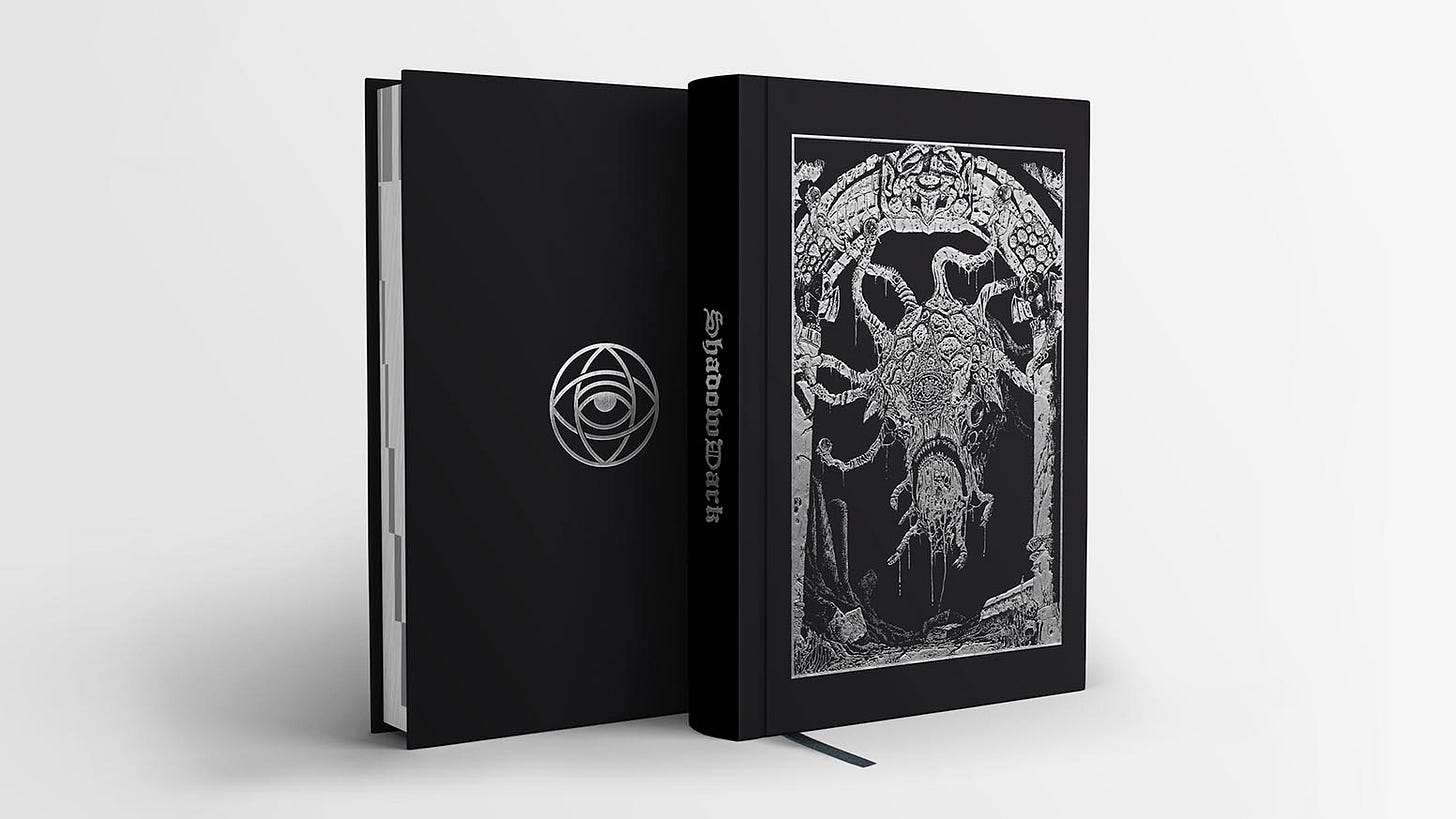
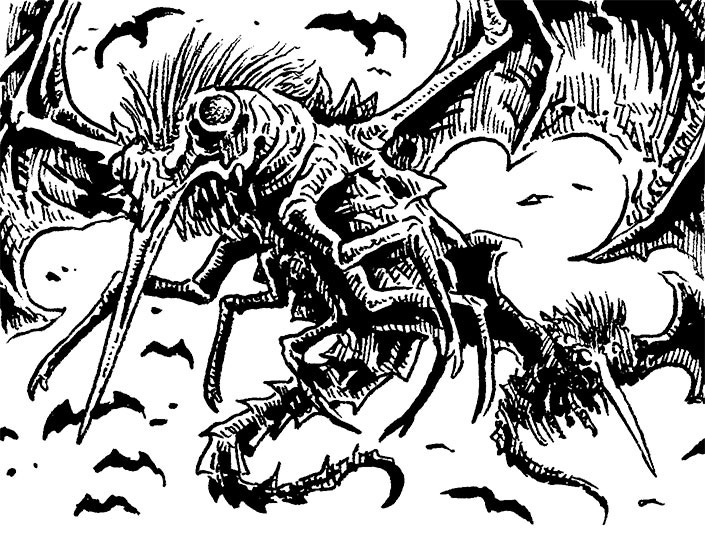

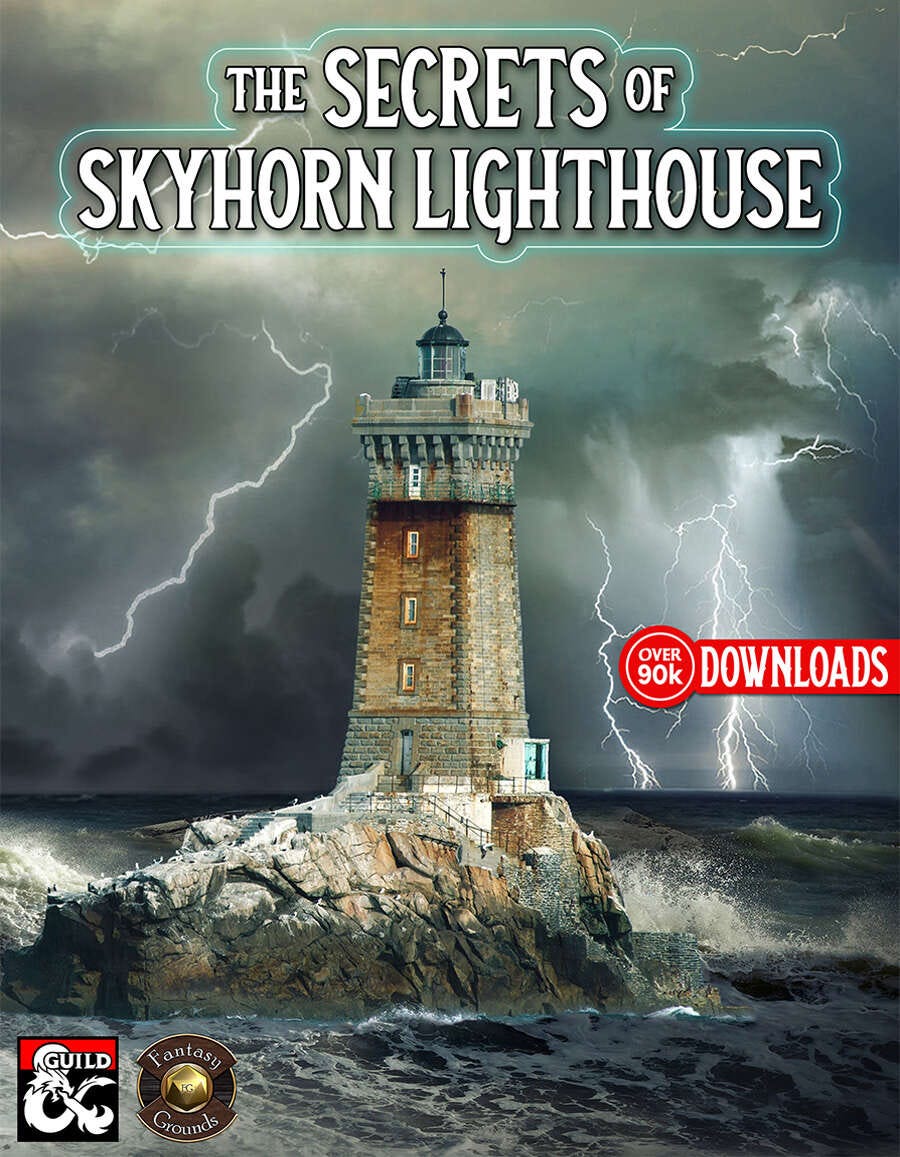


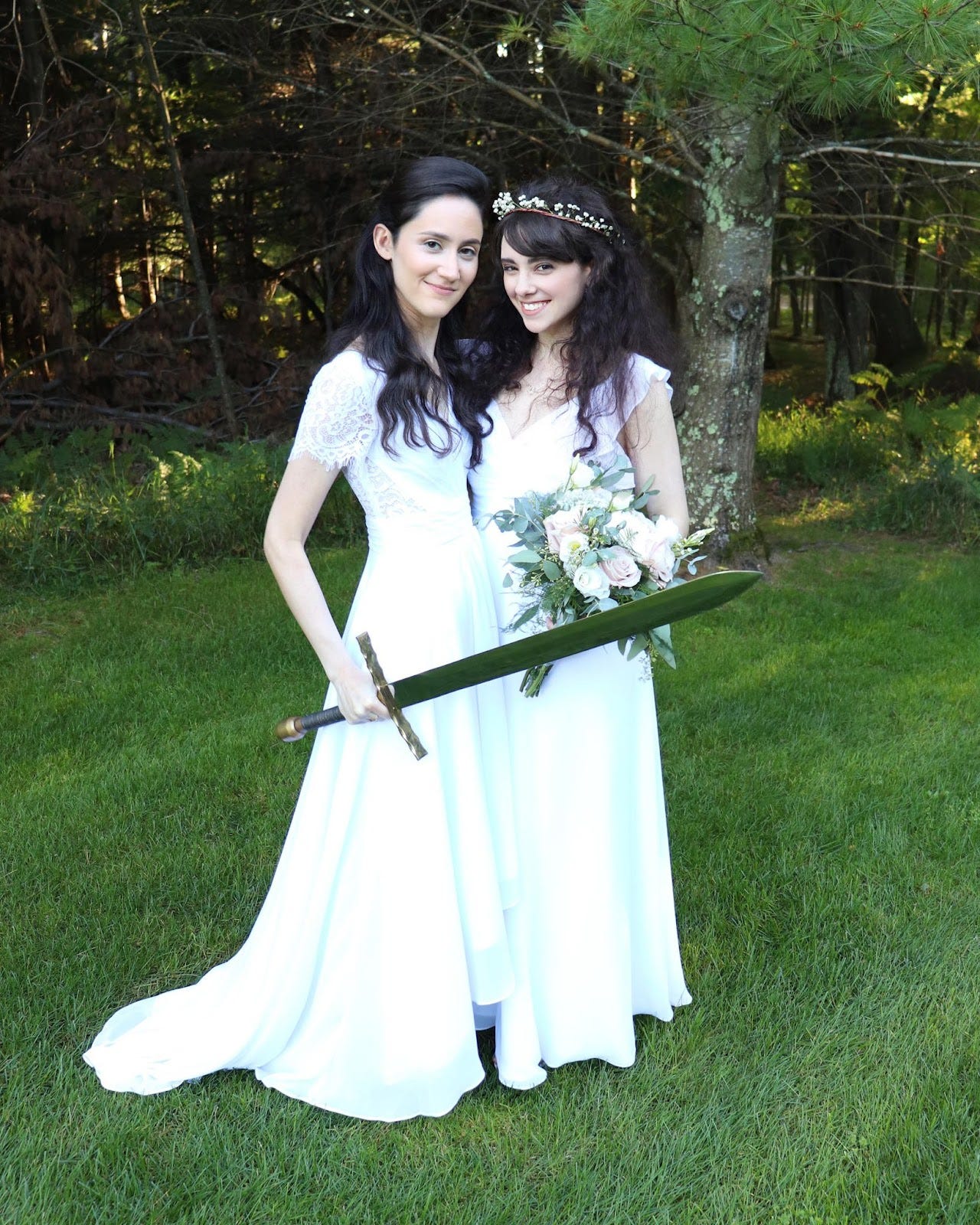
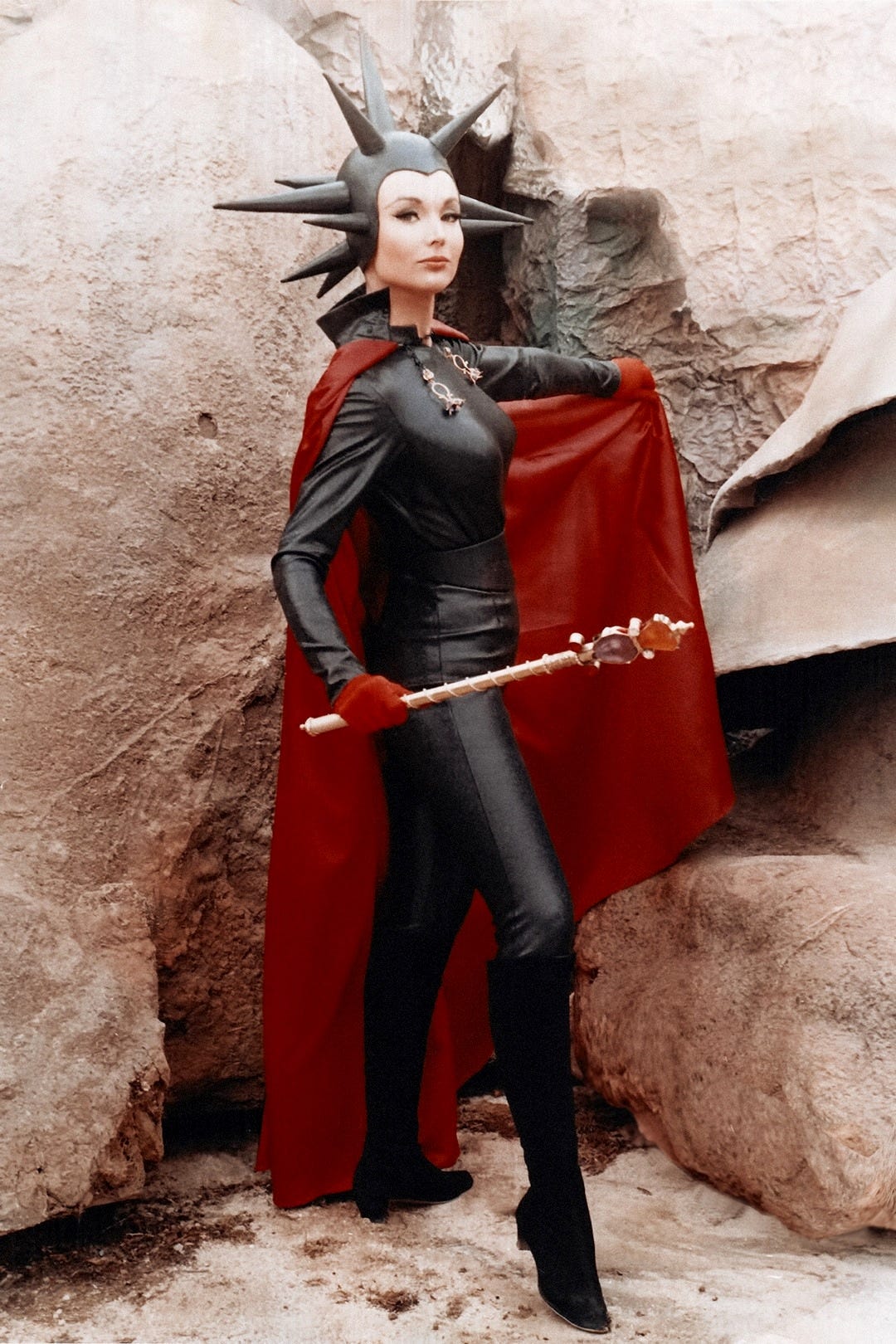
Great interview! I got to play test a session of Shadowdark with Kelsey, and it was a blast. Very happy for her success with the kickstarter.
Love everything I've seen from Kelsey. I've never been that interested in OSR type games, but Shadowdark really has me rethinking that. I'll definitely be checking this one out. Great interview!